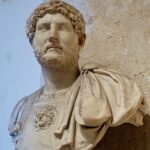Chapters
Archaeologists excavating and researching Hadrian’s villa in Tivoli say they have discovered the purpose of the semicircular, dedicated building in Hadrian’s villa. As they say, the emperor could eat breakfast there. This place, however, was not private and was more aimed at emphasizing the position of the emperor.
Researchers have reconstructed what the Emperor’s breakfast (ientaculum) might have been like. The emperor and his wife sat on thrones, on a high marble platform that was surrounded by fountains. The platform was connected to four bedrooms, each of which had a toilet decorated with marble panels and precious gemstones. The breakfast eaten was clearly visible from the outside through the large glazed windows, creating the illusion of some kind of performance for the members of the court. According to archaeologists, this building, as well as many others in the palace, were intended to present the emperor’s divinity.
The famous historian Mary Beard criticized the presented interpretation of the researchers.
Hadrian’s Villa
Hadrian’s Villa (Villa Adriana) was built on the order of Emperor Hadrian in Tivoli (a city approximately 28 kilometres from the capital) in 118-134 CE. The villa occupied an area estimated to be between 80 and 300 hectares. The preserved ruins now occupy an area of about 56 hectares. It was the most extensive palace buildings of the antiquity period.
The massive complex consisted of more than 30 buildings built in Roman and Greek architectural styles, echoing the many places Hadrian visited during his long journeys. There were fountains, gardens, pools and baths in the palace; the water was supplied through the same aqueducts that brought water to Rome.







